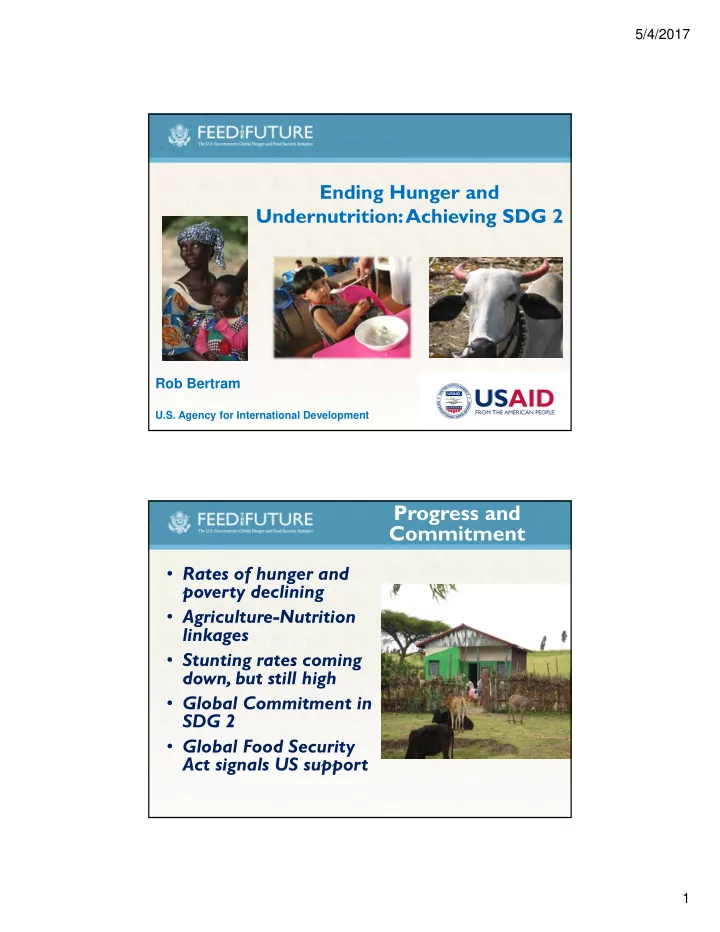

5/4/2017 Ending Hunger and Undernutrition: Achieving SDG 2 Rob Bertram U.S. Agency for International Development Progress and Commitment • Rates of hunger and poverty declining • Agriculture-Nutrition linkages • Stunting rates coming down, but still high • Global Commitment in SDG 2 • Global Food Security Act signals US support 1
5/4/2017 Poverty and hunger declining –but Africa lags Prevalence of poverty (US $1.25/day, 2005 PPP), (%) Prevalence of undernourishment (%) 100 40 East Asia South Asia 1990-92 80 SSA World 2012-14 30 60 20 40 10 20 0 0 World Africa Asia Pacific LAC 1981 1984 1987 1990 1993 1996 1999 2002 2005 2008 2011 Source: PovCalNet 2015 Source: FAO 2015 Hidden Hunger Index (micronutrient deficiencies) Source: Muthayya et al. 2015 GFSA Results Framework 2017 to 2021 2
5/4/2017 Agricultural growth is poverty-reducing Poverty-growth elasticities (US$1.25 poverty line) Malawi Mozambique Tanzania Uganda Zambia 0 -0.5 -1 -1.5 -2 All sectors -2.5 Agriculture Non-agriculture -3 Source: Dorosh and Thurlow, 2014 Agricultural growth continues to be more poverty- reducing than non-agricultural growth Agricultural growth reduces hunger Agricultural growth enhances hunger reduction • Increases household incomes and diversifies diets • Reduces food prices to benefit poor net food buyers • Creates employment; stimulates rural nonfarm economy Calorie deficiency-growth elasticities, Whether subsectoral growth Tanzania (2000-07) reduces hunger depends on 0 • Its linkages with rest of economy -0.5 Percent • Its initial size and geographic -1 concentration -1.5 • Its growth potential -2 Maize Pulses & Horticulture Livestock Export oilseeds crops • Market opportunities Source: Fan and Brzeska 2012 Source: Pauw and Thurlow 2010 3
5/4/2017 Economic growth and nutritional outcomes Increases in households’ purchasing power directly impacts nutrition Rice Rice and vegs Rice, vegs, and eggs Rice, vegs, eggs, meat Not poor Rice Rice and vegs Rice and eggs Rice and meat Less poor Rice Rice and vegs Rice and eggs Moderate poor Rice Rice and vegs Very poor Rice Very, very poor From Martin Bloem, UNICEF 4
5/4/2017 Stress Tolerant Maize during El Niño SC513 CZH132018 Murewa, Zimbabwe Peter Setimela What Small Scale Irrigation can look like 5
5/4/2017 24% of the world’s 667 million children are stunted Diverse nutritional status demands diverse solutions Low income countries Middle income countries Reduce 40 40 micro ‐ nutrient 35 35 deficiency 30 30 25 25 20 20 15 15 10 10 5 5 0 0 Hungry Stunted children Obese Hungry Stunted children Obese Reduce excessive Reduce energy High income countries net energy and 40 deficiency unhealthy diets 35 30 25 % population 20 15 10 5 0 Hungry Stunted children Obese 6
5/4/2017 What Works to Reduce Undernutrition? • Nutrition-specific interventions are those that address the immediate causes of undernutrition – Health Status – Nutrient Intake • Examples – Infant and Young Child Feed Practices/ENA – Micronutrient fortification/supplementation: Iron, Zinc, Vit. A – Integrated Management of Child Illness – Community Management of Acute Malnutrition 13 Contribution of Different Sectors to Improving Nutrition Globally Water & Food: 32% Sanitation: 35% Women’s Education + status: 33% 116 developing countries (1970-2010) Source: Smith and Haddad, 2013 Marie Ruel, IFPRI 7
5/4/2017 Nutrition-Sensitive Agriculture Target production of nutrient-rich foods, ideally those that include nutrients lacking in diet Include behavior change communication component specifically aimed at consumption of target crops Ensure target food availability and affordability in local markets and support consumption education Measure outcomes, including intermediate targets such as consumption and market availability 15 Rhoda Mang’anya supports 7 people on ~1/2 ha. Today she uses improved maize varieties and fertilizers, but only because of what else she does. 8
5/4/2017 “ I started keeping pigs and goats to support my children in school…and buying of salt, sugar, soap, relish.” Evidence? In Ethiopia Cow ownership reduced • stunting by 6-13% In millennium development village clusters Households with livestock are • more likely to consume animal- source foods Linking animal-source food • consumption with anthropometric measures is complex and influenced by other variables photo credit: ILRI/Apollo Habtamu 9
5/4/2017 Meat group • Highest Raven scores • Higher Vit. B12 status • More physical activity • More Arm muscle mass • More leadership • Higher test scores • More playful Milk group • Improved growth • Higher test scores • Higher B12 status Adapted from Demment, 2013 10
5/4/2017 Aflatoxin Produced by Aspergillus flavus, A. parasiticus • – Maize, peanuts, tree nuts, cottonseed, spices – Exposure highest in warm regions where maize & peanuts are dietary staples (Africa, Asia) Human health effects • – Liver cancer • Synergizes with chronic hepatitis B virus (HBV) infection: much higher risk than either exposure alone • P450 enzymes in liver transform aflatoxin to epoxide form, binding to DNA: DNA lesions cancer – Childhood stunting, acute aflatoxicosis (liver failure), immunomodulation Each year: up to 200,000 global aflatoxin-related liver • cancer cases (Liu and Wu 2010, Liu et al. 2012) 21 Interventions to reduce mycotoxin risk • Preharvest Dietary – Good agricultural Improved dietary variety practices Dietary enterosorbents – Genetically enhancing (binders) plants’ resistance NovaSil used – Biocontrol commonly in US animal feed • Postharvest Dietary chemoprevention Chlorophyll, chlorophyllin – Improved sorting, Compounds in cruciferous drying, food storage & Allium vegetables Triterpenoids (in grasses, herbs, apple peels) from Felicia Wu, 2017 11
5/4/2017 Please See our Feed the Future Website www.feedthefuture.gov 12
Recommend
More recommend